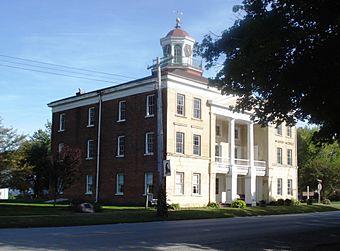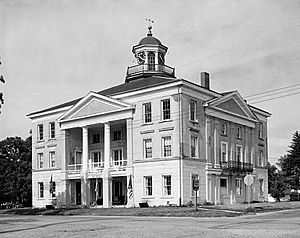Bishop Hill Colony facts for kids
|
Bishop Hill Historic District
|
|

Steeple Building
|
|
| Lua error in Module:Location_map at line 420: attempt to index field 'wikibase' (a nil value). | |
| Location | Bishop Hill, Illinois |
|---|---|
| Built | 1846 |
| Architect | Multiple |
| Architectural style | Greek Revival |
| NRHP reference No. | 70000244 |
Quick facts for kids Significant dates |
|
| Added to NRHP | April 17, 1970 |
| Designated NHLD | April 27, 1984 |
The Bishop Hill Colony is a special historic place in Bishop Hill, Illinois. It was once a unique community where people lived and worked together, sharing everything. This community was founded in 1846 by a Swedish religious leader named Eric Janson and his followers. They called their new home Bishop Hill, named after a town in Sweden.
History of Bishop Hill Colony
The Bishop Hill Colony was started in 1846 by a group of Swedish people. They had different religious ideas and wanted to create a new life in Illinois. This community was run like a commune, meaning everyone shared resources and worked together. It lasted until 1861.
Bishop Hill was a very important Swedish settlement in Western Illinois. It influenced larger Swedish-American communities nearby. Today, the buildings, old items, and records from Bishop Hill help us learn about immigration and how people lived in shared communities in the 1800s.
Many important old buildings still stand in the village. Four of these buildings are owned by the state of Illinois. They are part of the Bishop Hill State Historic Site. The state also owns the village park, which has a gazebo and memorials. These memorials honor the first settlers and soldiers from the American Civil War.
A museum building made of brick holds a valuable collection of folk art paintings. These were created by an early colonist named Olof Krans. Because of its importance, Bishop Hill was named a National Historic Landmark in 1984. In 2018, Bishop Hill Colony was chosen as one of the "Illinois 200 Great Places." This was part of the state's 200th birthday celebration.
Who Was Erik Janson?
The village was founded and led by Erik Janson. Before starting the Bishop Hill Colony, Janson taught his followers in Sweden. He believed the main church there had many problems. He also taught that truly faithful people could live without sin.
As Janson's ideas became more extreme, some of his supporters left him. He was forced to leave Sweden because of growing opposition. Janson had sent a trusted follower, Olof Olsson, to the United States. Olsson's job was to find a good place for Janson's followers to build a new community. Janson believed this community would be a "New Jerusalem," a perfect religious place. He thought their beliefs would then spread worldwide. About 1,400 colonists came from Sweden to their new home in western Illinois.
Life in the Colony
The colony faced many challenges when it first started. Many of the first 1,000 colonists died from sickness on their journey to Bishop Hill. Others became discouraged and stayed in New York. The living spaces in Bishop Hill were cold and crowded. Food was also hard to find.
After the first winter, life at the colony began to get better. In the next few years, homes improved from simple dugouts to brick buildings. Crops were planted on about 700 acres (2.8 square kilometers) of land. By 1849, Bishop Hill had built a flour mill and two sawmills. They also built a three-story church and many other buildings.
The Bishop Hill Colony was a communistic community. This means that everything was owned by everyone, not by individuals. No one had more belongings than anyone else. Work in the colony was very hard and organized. It was common to see hundreds of people working together in the fields. Large groups of workers also did other tasks together.
Images for kids






